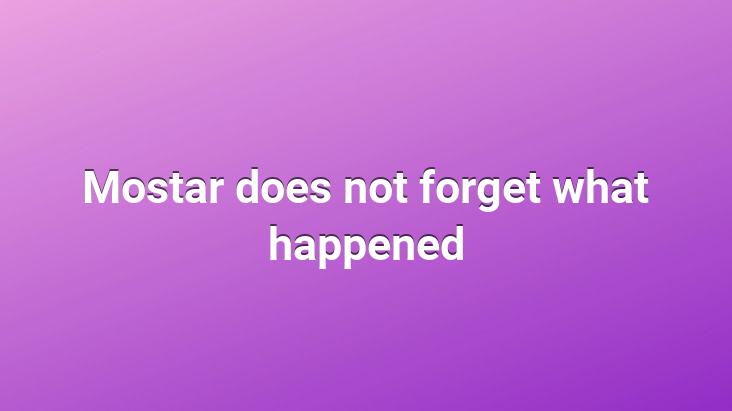We are in the lands of the Balkans where great fighting and slaughter took place.. Our destination is Mostar. Mostar, which is 140 km away from Dubrovnik where we are staying, is one of the places that Turks know well and hear its name frequently. Although the distances are short in our bus journey, transportation times are increasing due to difficult geographical conditions.. However, these long hours turn into visual pleasure rather than torture.. The Republic of Bosnia and Herzegovina, one of the states that emerged with the disintegration of the Yugoslav Federation, consists of two separate sub-ethnicities.. One is the Federation of Bosnia and Herzegovina, after which the republic is named, and the other is the Republika Srpska, formed by Serbs.. Even those who are interested in this geography and often pronounce the name of the country are not aware of this distinction.. However, the two sub-states have shared the lands with sharp distinctions between 51 percent and 49 percent.. In fact, the efforts of Republika Srpska to leave the Federation of Bosnia and Herzegovina have been voiced loudly recently.
Border crossings
Leaving Dubrovnik and making our way through the northern corridor, we arrive at the border gate separating Croatia and Bosnia-Herzegovina before a long time.. Sovereign powers, which fueled the divisions when there was a division in the region, were also involved in the drawing of the borders.. While Croatia took the entire Adriatic coast, the remaining 12 km part was left to Bosnia and Herzegovina.. This Bosnian city called Neum is the country’s only breathing center to the sea.. However, it is forbidden to establish a port in Neum due to the agreements made.. Bosnia-Herzegovina people living in the country surrounded by large mountains under a continental climate come to this region and have a holiday in the summer months.. With the borders drawn in this way, we have to enter Bosnia first, then Croatia, and for the last time, Bosnia again, on the way from Dubrovnik to the north, to Mostar.. This means more customs and border control for foreigners.
Croats and Bosniaks do not cause each other much difficulty in crossing each other.. However, if you are not an EU citizen, you may be subject to strict controls at the Croatian customs.
We are in Neum…
Bosnia-Herzegovina’s Adriatic We stop in Neum, the only city on the coast but without a port.. To go to Mostar, we will stop by the Croatian lands once again and then say hello to the Bosnian borders again.
The currency of Bosnia and Herzegovina is the Convertible Mark, briefly expressed as KM.. 1 Convertible Mark is equal to 4 Croatian Kuna, 2 Convertible Mark is equal to 1 Euro. While we are happy that the prices in Neum are written according to the Croatian Kuna, we are disappointed when we realize that the tariff we actually see is the Covertbl Mark.. Shopping with 1 KM, which is equal to 50 euro cents, does not seem very logical with this tariff.. We continue on our way with little confusion after comparative currencies.
225 km. Dozens of agricultural products are grown in the fertile valley irrigated by the Neretva, the most important river of the region with its length.. The mild effect of the Mediterranean climate is closely felt in this valley.. We leave Croatian territory once more as we curve towards Mostar.. Metkovic border gate is another one of the border gates between the two countries.. After a long waiting time in the queue of buses, trucks and private vehicles lined up in a row, we enter Bosnian territory through the gate that opens from Croatia to Mostar.. Changing sides so often between the two countries in a short time makes us think…
As we move towards the Ottoman Village Poçitel
As we move towards Mostar We arrive in Pocitel, a typical Ottoman village located in the Neretva valley.. The village, which is an important stop for Turkish tourist groups visiting the region, draws attention with its mosque and lifestyle.. Everyone is running around seeing the article “Turkish Tea is available”, which gives good news to those who yearn for Turkish Tea, in the cafe at the entrance of the village. … Tea has also been translated into regional languages from Turkish.. In Bosnian, tea is spelled “Caj”. The tail, which is under the letter “ç” in our country, is located above the letter c in Bosnian.. Pronunciation is almost the same.. In 1465, it was made high security with the castle built by the Croatian-Hungarian King, together with the threat of the Turks from Poçite, which was connected to the province of Herzegovina during the Ottoman period.. After the existence of the village, which could be an important surveillance center, was noticed by the Ottoman Empire, the village passed under Ottoman rule.. Turkish traces also spread in the village, where the castle structure was expanded.. The village gained its present appearance with structures such as mosque, madrasa, Turkish bath and clock tower.. As a reflection of 415 years of Ottoman rule, Turkish flags still hang inside the Poçitel Mosque today.. The population of the village, which was established on a very rough terrain, is very low.. During the disaster days of the 90s, the male population decreased.. Women who lost their spouses in the war struggle to make a living by selling fruit to tourists.. Again, handmade products and souvenirs are sold in every corner.. While the hill in the village, which has been included in the UNESCO’s Cultural Heritage List, greets all guests in a majestic manner, the Neretva River flowing in its back fascinates us all.. While we struggle to walk without slipping on the stone stairs, we take a breather in the courtyard of Hacı Ali Mosque.. We later learn that the mosque, which we respect for its centuries-old age, was badly damaged during the bombardment and was repaired by UNESCO.. The break for watching the village and breathing is coming to an end quickly. As we get on the buses, we are getting closer to the magic of Mostar, which I have been curious to see for years… Our guide adds an interesting information that Gaddafi came to the city in 1966 to take pilot training.. In those years, the city was centered on military bases.
Entrance to Mostar…
With the announcement of our guide, 1 from Poçitel After about an hour, we realize that we have entered the borders of Mostar.. The bridge we see when we turn our heads to the right gives goosebumps to the whole caravan.. While everyone is photographing the bridge with the cameras they hug, being approaching the bridge that has witnessed history increases our excitement breathlessly. Mostar, the capital of the province of Herzegovina with a population of approximately 105 thousand, is the fifth largest city in Bosnia. It has an important place in the memories of the whole world with its narrow streets, Turkish traces and most importantly hosting the war images of the 90s. we are moving forward. Before stepping into the narrow street that will take us to the bridge, the intersection we were waiting to cross was the line that divided Mostar into two in the past.. Beyond the line is the living space of the Muslims, the back we expect is the region where the Serbs live.. When we look at the buildings carefully, it is impossible not to notice the deep bullet and bomb wounds.. Frankly, encountering such heavily damaged buildings in a place that can be considered the heart of Europe is more than enough to make us question our humanity.. Confronting the cold face of war makes you feel uncomfortable and indescribable.. A mosque on one side, a church next to it and a synagogue a little further away… Martyrdoms in the middle of it all… The common fate of these people, who was the last day of their lives in 1993, was war victims.. Walking with bullets and shrapnel marks in every building, in the side streets… Recent history is hitting us alive.
We are approaching the old bridge (Stari Most).. Mostar Bridge, which was built during the Ottoman period and destroyed during the war, has been rebuilt.. While the bridge was being rebuilt, parts of the river were searched and found as much as possible, but of course, a newer bridge emerged instead of the old one.. Fortunately, all dimensions and architectural features are exactly the same.. Before the war, the city was mostly Muslim, now it is divided in two by the Mostar Bridge.. Muslims on one side and non-Muslims on the other.. Even though the war seems to be over and everything is forgotten, even in friendly matches that bring the two sides face to face, there may be situations where the intervention of the security forces is necessary.
The story of the bridge.
The bridge built in 1566 by Mimar Sinan’s student, Mimar Hayruddin, on the Neretva River, used 456 blocks of stone.. The bridge, which was 24 meters high, 30 meters long and 4 meters wide, was used as a jumping platform for brave athletes.. According to tradition, the men of the city used to jump off this bridge before the wedding to prove their courage to their fiancees. You can still come across men in swimsuits waiting to perform on the bridge.. They are waiting to jump into the cool waters of the river for about 30 Euros.
The bridge was completely destroyed by the attacks of the Bosnian Serbs in 1992 and the Croatian tanks in 1993, and the giant stones of the bridge were buried in the waters of the Neretva River.. With the demolition of the bridge, which is the symbol of Mostar’s tolerance and cultural diversity, the differences have increased even more.. Since all the bridges in the region were destroyed during the war, the British managed to connect the two sides with a temporary iron bridge they built over Mostar after a long time.
The Mostar Bridge, which was reopened by Prince Charles in 2004, was restored with the meticulous work of the Turkish construction company and international aid. Turkey has a large share in these aids.. Today, the Croats continue to live in the west of the river and the Bosnians in the east of the river.. So Mostar has a view that separates the two peoples.. The Serbs who immigrated during the war did not return to the region again.
While we are smiling at the Consulate General of the Republic of Turkey in Mostar, which we encountered on our short tour, it is possible to come across the Turkish flag frequently here.. We are going to Şadırvan, which is visited by almost everyone who comes to Mostar for traditional Bosnian tastes.. We order the famous answer cici (Bosnian Meatballs).. With the migration of Bosnians to Anatolia, their food culture was also carried to our lands.. Prices in the streets of Bosnia and Herzegovina, which display a very modest appearance after Croatia, are also very affordable.. When it comes to a nice meal for four people, about 25-30 Euros, we are very pleased. One of the most beautiful stops of the Balkans, Mostar needs more tourists to take a breather.. That’s why they call Turkey to Turkish citizens. I think we should listen to the calls of the Bosnians with whom we took part in the common pages of history.. Bosnia and Herzegovina should be tried for different experiences instead of the usual, classical tours.







